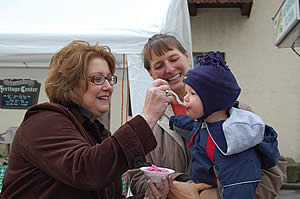Although the perception is that one must have a giant sugarbush, and lots of specialized equipment to make maple syrup, our blogger Lisa Amstutz tells how she does it in her back yard!Â
I fell in love with the gigantic silver maple tree in my back yard at first sight. Several feet in diameter, it towered above everything else in the yard and had tree swing potential written all over it. The tree has lived up to expectations in that department. It has also provided cool shade on hot summer days and homes for many of the birds we so enjoy watching.
As if that wasn’t enough, my lovely silver maple literally has sugar running in its veins. While sugar and black maples make the best maple syrups, red and silver maples work well too, as does box elder. “Maple†syrup can even be made from certain species of birch.

Sugaring season varies every year, but it often starts at the end of February or beginning of March, when the nights are below freezing and daytime temperatures rise to around 40°, and lasts until the trees begin to break bud. During the last week in February, we finally got around to tapping our tree, a week or two after we started seeing bags and buckets on our neighbors’ trees.
It’s not difficult to make maple syrup. The supplies are inexpensive—I spent about $25 for two bags, holders and spouts that can be reused year after year. Some syrup-makers prefer to use plastic tubing and 5-gallon buckets or just hang a bucket or milk jug directly on the spout.
The biggest problem for many backyard syrup-makers is finding a good place to boil down the sap. It takes roughly 40 gallons of sap to make a gallon of syrup, which means that large quantities of water must boil off. If you try to do it on your kitchen stove, you’ll steam off the wallpaper and end up with a sticky mess unless you have a stellar ventilation system.

For our small quantities, we’ve found that cooking the sap on a hot plate on the porch works fine, as long as we keep a close eye on it. If you have more trees, you may need to cook it in a kettle over a fire or rig up an evaporator. The syrup is ready at about 66° Brix, or when it boils at 7.1° F above the boiling temperature of water. At that point, there’s nothing left to do but make pancakes and enjoy!
Besides its taste benefits, real maple syrup has the advantage of being all-natural—most commercial “maple syrup†brands have little to no actual maple syrup in them but rather a cocktail of corn syrup, preservatives, and artificial colors and flavors. In addition, maple syrup is one of the few truly local sweeteners available in northern climates.

Of course, our one tree produces only enough syrup to whet our appetite for more, but it does make for a few wonderfully memorable pancake breakfasts each year. Even if you only have one or two maple trees in your yard, why not give backyard sugarin’ a try this year?





























